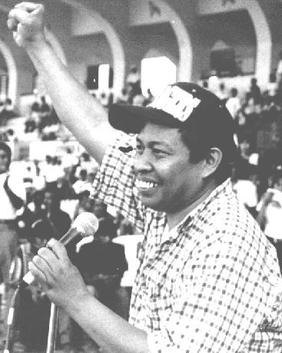Filemon Lagman facts for kids
Quick facts for kids
"Ka Popoy" Lagman
|
|
|---|---|
 |
|
| Personal details | |
| Born |
Filemon Castelar Lagman
March 17, 1953 |
| Died | February 6, 2001 (aged 47) Quezon City, Philippines |
| Cause of death | Assassination by gunshots |
| Nationality | Filipino |
| Political party | Partido Manggagawa (1999–2001) Sanlakas (1993–2001) Communist Party of the Philippines (until 1991) |
| Relations | Edcel Lagman (brother) |
| Occupation | Marxist theoretician, Labor Group Leader |
| Known for | Founder of Bukluran ng Manggagawang Pilipino (BMP), Kapatiran ng mga Pangulo ng Unyon sa Pilipinas (KPUP) |
Filemon Castelar Lagman (March 17, 1953 – February 6, 2001), known as Ka Popoy, was a Filipino leader who fought for workers' rights. He believed in socialist ideas. He helped create groups like the Bukluran ng Manggagawang Pilipino (BMP). He was sadly killed in 2001.
Contents
Who Was Ka Popoy Lagman?
Early Life and Family
Filemon Castelar Lagman was born on March 17, 1953. His parents were Pedro Eduardo Lagman, Jr. and Cecilia Castellar-Lagman. He grew up in Caloocan, a city in the Philippines. In high school, he was a track and field athlete.
Ka Popoy had two wives during his life. His first wife was Dodi Garduce. His second wife was Bobbie Jopson. His brother, Edcel Lagman, is a congressman for Albay.
Starting His Activism
Ka Popoy began showing his strong political views in high school. He often debated with teachers who didn't agree with his ideas. In the 1970s, he joined a youth group called Samahang Demokratiko ng Kabataan.
After just one year at the University of the Philippines, he decided to work full-time. He helped organize workers in factories and poor communities. When martial law was declared in 1972, Ka Popoy helped set up a secret network. This network was part of a revolutionary movement in Navotas.
He worked with others to create labor unions in factories. He also helped organize large protests. He built support among workers and recruited new members for the Communist Party of the Philippines (CPP).
Ka Popoy's Leadership and Ideas
Leading the Movement
In the mid-1970s, Ka Popoy became the Secretary of the Manila-Rizal Regional Party Committee of the CPP. He led a large group that challenged the Marcos dictatorship. This group participated in the 1978 elections.
However, the main leaders of the CPP did not agree with this. They wanted people to fight the dictatorship through armed struggle in the countryside. Because of this disagreement, Ka Popoy was removed from his leadership role. He only returned after the People Power Revolution in 1986. Even with these differences, Ka Popoy continued his revolutionary work in the capital city.
New Ideas and New Groups
Ka Popoy had different ideas about how to change society. He believed that Philippine society was capitalist, but in a less developed way. He thought that a revolution led by workers was needed to fix this. This was different from the CPP's idea of a long war from the countryside.
In 1991, because of these differences, he left the CPP. He then helped create new groups. One was the Bukluran ng Manggagawang Pilipino (BMP). This group focused on workers' rights. He also helped form Sanlakas, a group for many different sectors. He also led the creation of the Partido ng Manggagawang Pilipino (Filipino Workers' Party). This was a secret socialist party.
Ka Popoy's Legacy
His Tragic Death
On February 6, 2001, Ka Popoy was attacked and shot. This happened at the University of the Philippines-Diliman in Quezon City. At the time, he was working to launch the Partido ng Manggagawa. This was a political party for workers that would join the 2001 elections.
Many people believe his death was planned by a group from the military. They might have wanted to cause problems for the new government. Police investigations suggested the attackers might have been from another group that had also split from the CPP. The people who killed him were never caught. In 2007, the case was dropped because witnesses could not attend the investigations.
Ka Popoy is remembered as a strong leader who fought for the rights of Filipino workers.
Images for kids



